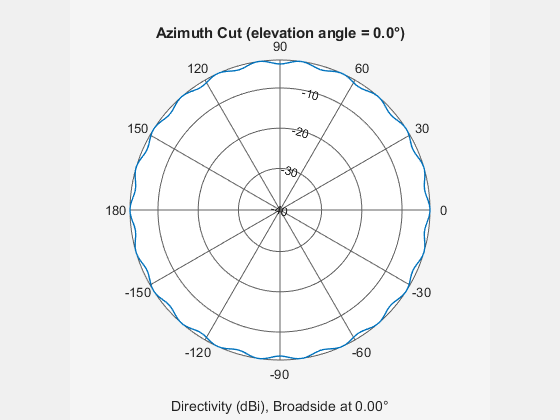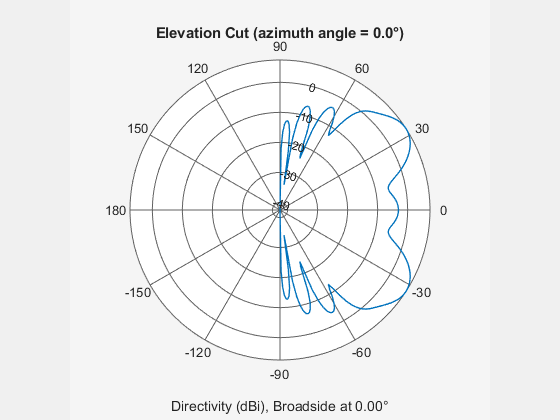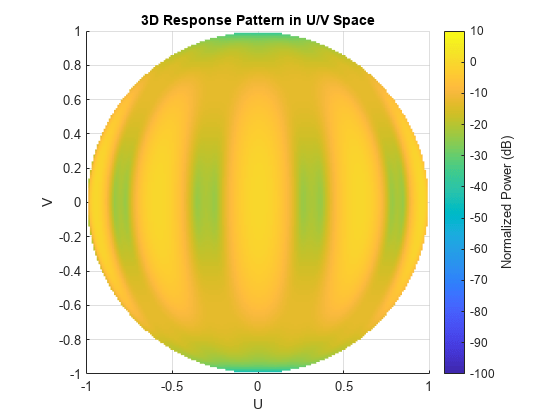pattern
System object: phased.UCA
Namespace: phased
Plot UCA array pattern
Syntax
pattern(sArray,FREQ)
pattern(sArray,FREQ,AZ)
pattern(sArray,FREQ,AZ,EL)
pattern(___,Name,Value)
[PAT,AZ_ANG,EL_ANG] = pattern(___)
Description
pattern( plots
the 3-D array directivity pattern (in dBi) for the array specified
in sArray,FREQ)sArray. The operating frequency is specified
in FREQ.
The integration used when computing array directivity has a minimum sampling grid of 0.1 degrees. If an array pattern has a beamwidth smaller than this, the directivity value will be inaccurate.
pattern( plots
the array directivity pattern at the specified azimuth angle.sArray,FREQ,AZ)
pattern( plots
the array directivity pattern at specified azimuth and elevation angles.sArray,FREQ,AZ,EL)
pattern(___,
plots the array pattern with additional options specified by one or
more Name,Value)Name,Value pair arguments.
[PAT,AZ_ANG,EL_ANG] = pattern(___)PAT. The AZ_ANG output
contains the coordinate values corresponding to the rows of PAT.
The EL_ANG output contains the coordinate values
corresponding to the columns of PAT. If the 'CoordinateSystem' parameter
is set to 'uv', then AZ_ANG contains
the U coordinates of the pattern and EL_ANG contains
the V coordinates of the pattern. Otherwise, they
are in angular units in degrees. UV units are dimensionless.
Note
When you need to compute array or element directivity, you can either set the
Type property to "directivity" in the
pattern object function or use the directivity
object function. For a small number of angular directions, it may be more computationally
efficient to use the directivity object function. The
pattern object function is more efficient for computing directivity
for larger angular regions.
Input Arguments
Uniform circular array, specified as a phased.UCA System object.
Example: sArray= phased.UCA;
Frequencies for computing directivity and patterns, specified as a positive scalar or 1-by-L real-valued row vector. Frequency units are in hertz.
For an antenna, microphone, or sonar hydrophone or projector element,
FREQmust lie within the range of values specified by theFrequencyRangeorFrequencyVectorproperty of the element. Otherwise, the element produces no response and the directivity is returned as–Inf. Most elements use theFrequencyRangeproperty except forphased.CustomAntennaElementandphased.CustomMicrophoneElement, which use theFrequencyVectorproperty.For an array of elements,
FREQmust lie within the frequency range of the elements that make up the array. Otherwise, the array produces no response and the directivity is returned as–Inf.
Example: [1e8 2e6]
Data Types: double
Azimuth angles for computing directivity and pattern, specified as a 1-by-N real-valued row vector where N is the number of azimuth angles. Angle units are in degrees. Azimuth angles must lie between –180° and 180°.
The azimuth angle is the angle between the x-axis and the projection of the direction vector onto the xy plane. When measured from the x-axis toward the y-axis, this angle is positive.
Example: [-45:2:45]
Data Types: double
Elevation angles for computing directivity and pattern, specified as a 1-by-M real-valued row vector where M is the number of desired elevation directions. Angle units are in degrees. The elevation angle must lie between –90° and 90°.
The elevation angle is the angle between the direction vector and xy-plane. The elevation angle is positive when measured towards the z-axis.
Example: [-75:1:70]
Data Types: double
Name-Value Arguments
Specify optional pairs of arguments as
Name1=Value1,...,NameN=ValueN, where Name is
the argument name and Value is the corresponding value.
Name-value arguments must appear after other arguments, but the order of the
pairs does not matter.
Before R2021a, use commas to separate each name and value, and enclose
Name in quotes.
Plotting coordinate system of the pattern, specified as the comma-separated pair consisting of
CoordinateSystem and one of "polar",
"rectangular", or "uv". When
CoordinateSystem is set to "polar" or
"rectangular", the AZ and
EL arguments specify the pattern azimuth and elevation,
respectively. AZ values must lie between –180° and 180°.
EL values must lie between –90° and 90°. If
CoordinateSystem is set to "uv",
AZ and EL then specify
U and V coordinates, respectively.
AZ and EL must lie between -1 and
1.
Example: "uv"
Data Types: char
Displayed pattern type, specified as the equal-sign-separated pair consisting of
Type and one of
"directivity"— directivity pattern measured in dBi."efield"— field pattern of the sensor or array. For acoustic sensors, the displayed pattern is for the scalar sound field."power"— power pattern of the sensor or array defined as the square of the field pattern."powerdb"— power pattern converted to dB.
Example: "powerdb"
Data Types: char
Array orientation, specified as a 3-by-1 real-valued column vector containing three rotation angles. The three angles define orthogonal rotations with respect to the x-, y-, and z-axes of the local coordinate system. To create the full orientation matrix, the orthogonal rotations are applied in this order:
a rotation around the positive x-axis by the angle θx.
a rotation around the positive y-axis by the angle θy.
a rotation around the positive z-axis by the angle θz.
Positive angles are defined using the right-handed rule. A positive angle defines a rotation that appears clockwise when looking towards the positive direction of the axis, and negative values when the rotation appears counter-clockwise. The right-hand rule is invoked by pointing the right-hand thumb along an axis. Then the other fingers of the right hand curl in the positive direction,
Display normalized pattern, specified as the comma-separated pair consisting of
Normalize and a Boolean. Set this parameter to
true to display a normalized pattern. This parameter does not
apply when you set Type to "directivity".
Directivity patterns are already normalized.
Data Types: logical
View the array geometry along with the 3D radiation pattern, specified as
false or true.
Data Types: logical
Show the local coordinate axes, specified as true or false.
Data Types: logical
Show the colorbar, specified as true or false.
Data Types: logical
Handle to the axes along which the array geometry is displayed specified as a scalar.
Polarized field component to display, specified as the comma-separated pair consisting of
'Polarization' and 'combined', 'H', or
'V'. This parameter applies only when the sensors are
polarization-capable and when the 'Type' parameter is not set to
'directivity'. This table shows the meaning of the display
options.
'Polarization' | Display |
|---|---|
'combined' | Combined H and V polarization components |
'H' | H polarization component |
'V' | V polarization component |
Example: 'V'
Data Types: char
Signal propagation speed, specified as the comma-separated pair consisting of
PropagationSpeed and a positive scalar in meters per
second.
Example: PropagationSpeed="physconst('LightSpeed')"
Data Types: double
Array weights, specified as the comma-separated pair consisting
of 'Weights' and an N-by-1 complex-valued
column vector or N-by-L complex-valued
matrix. Array weights are applied to the elements of the array to
produce array steering, tapering, or both. The dimension N is
the number of elements in the array. The dimension L is
the number of frequencies specified by FREQ.
| Weights Dimension | FREQ Dimension | Purpose |
|---|---|---|
| N-by-1 complex-valued column vector | Scalar or 1-by-L row vector | Applies a set of weights for the single frequency or for all L frequencies. |
| N-by-L complex-valued matrix | 1-by-L row vector | Applies each of the L columns of 'Weights' for
the corresponding frequency in FREQ. |
Note
Use complex weights to steer the array response toward different
directions. You can create weights using the phased.SteeringVector System object or
you can compute your own weights. In general, you apply Hermitian
conjugation before using weights in any Phased Array System Toolbox™ function
or System object such as phased.Radiator or phased.Collector. However, for the directivity, pattern, patternAzimuth,
and patternElevation methods of any array System object use
the steering vector without conjugation.
Example: 'Weights',ones(N,M)
Data Types: double
Complex Number Support: Yes
Output Arguments
Examples
Create an 11-element uniform circular array (UCA) having a 1.5 m radius and operating at 500 MHz. The array consists of short-dipole antenna elements. First, display the vertical component of the response at 45 degrees azimuth and 0 degrees elevation. Then plot the azimuth and elevation directivities.
antenna = phased.ShortDipoleAntennaElement(... FrequencyRange=[50e6,1000e6], ... AxisDirection="Z"); array = phased.UCA(NumElements=11,Radius=1.5,Element=antenna); fc = 500e6; ang = [45;0]; resp = array(fc,ang); disp(resp.V)
-1.2247 -1.2247 -1.2247 -1.2247 -1.2247 -1.2247 -1.2247 -1.2247 -1.2247 -1.2247 -1.2247
Display the azimuth directivity pattern at 500 MHz for azimuth angles between -180 and 180 degrees.
c = physconst('LightSpeed'); pattern(array,fc,[-180:180],0,Type="directivity",PropagationSpeed=c)

Display the elevation directivity pattern at 500 MHz for elevation angles between -90 and 90 degrees.
pattern(array,fc,[0],[-90:90],Type="directivity",PropagationSpeed=c)
Create a 10-element UCA antenna array consisting of cosine antenna elements. Display the 3-D power pattern in UV space.
sCos = phased.CosineAntennaElement('FrequencyRange',[100e6 1e9],... 'CosinePower',[2.5,2.5]); sUCA = phased.UCA('NumElements',10,... 'Radius',1.5,... 'Element',sCos); c = physconst('LightSpeed'); fc = 500e6; pattern(sUCA,fc,[-1:.01:1],[-1:.01:1],... 'CoordinateSystem','uv',... 'Type','powerdb',... 'PropagationSpeed',c)

More About
Directivity describes the directionality of the radiation pattern of a sensor element or array of sensor elements.
Higher directivity is desired when you want to transmit more radiation in a specific direction. Directivity is the ratio of the transmitted radiant intensity in a specified direction to the radiant intensity transmitted by an isotropic radiator with the same total transmitted power
where Urad(θ,φ) is the radiant intensity of a transmitter in the direction (θ,φ) and Ptotal is the total power transmitted by an isotropic radiator. For a receiving element or array, directivity measures the sensitivity toward radiation arriving from a specific direction. The principle of reciprocity shows that the directivity of an element or array used for reception equals the directivity of the same element or array used for transmission. When converted to decibels, the directivity is denoted as dBi. For information on directivity, read the notes on Element Directivity and Array Directivity.
The U/V coordinate system is determined by the array type and the array orientation. The Phased Array System Toolbox offers four basic array shapes: ULA, URA, UCA, and Conformal.
For the
phased.ULASystem object use theArrayAxisproperty to select the array orientation as"x","y", or"z". TheArrayAxisproperty determines the elements layout, the normal direction of the array, and the orientation of the U/V space as shown in the table here:ULA Array
ArrayAxis property value Array element positions Array normal U/V space for ULA U/V positive hemisphere for ULA Plot of U/V space for ULA in 3D space "x"x-axis positive y-axis xz-plane y≥0 "y"y-axis positive x-axis yz-plane x≥0 "z"z-axis positive x-axis yz-plane x≥0 For the
phased.URAorphased.UCASystem objects use theArrayNormalproperty to select the array orientation as"x","y", or"z". TheArrayNormalproperty determines the elements layout, the normal direction of the array, and the orientation of the U/V space as shown in the table here:URA and UCA Arrays
ArrayNormal property value Array element positions Array normal U/V space for URA/UCA U/V positive hemisphere for URA/UCA Plot of U/V space for URA/UCA in 3D space "z"xy-plane positive z-axis xy-plane z≥0 "y"xz-plane positive y-axis xz-plane y≥0 "x"yz-plane positive x-axis yz-plane x≥0 For the
phased.ConformalArraySystem object, uses theElementPositionproperty to determine the elements layout, the normal direction of the array, and the orientation of the U/V space as shown in the table here:Conformal Array
Array element positions Array normal U/V space for conformal array U/V positive hemisphere for conformal array Plot of U/V space for conformal array in 3D space Arbitrary in 3D space ElementPosition positive x-axis yz-plane x≥0
Version History
Introduced in R2015aEnhanced definitions of array axes and normals.
See Also
MATLAB Command
You clicked a link that corresponds to this MATLAB command:
Run the command by entering it in the MATLAB Command Window. Web browsers do not support MATLAB commands.
选择网站
选择网站以获取翻译的可用内容,以及查看当地活动和优惠。根据您的位置,我们建议您选择:。
您也可以从以下列表中选择网站:
如何获得最佳网站性能
选择中国网站(中文或英文)以获得最佳网站性能。其他 MathWorks 国家/地区网站并未针对您所在位置的访问进行优化。
美洲
- América Latina (Español)
- Canada (English)
- United States (English)
欧洲
- Belgium (English)
- Denmark (English)
- Deutschland (Deutsch)
- España (Español)
- Finland (English)
- France (Français)
- Ireland (English)
- Italia (Italiano)
- Luxembourg (English)
- Netherlands (English)
- Norway (English)
- Österreich (Deutsch)
- Portugal (English)
- Sweden (English)
- Switzerland
- United Kingdom (English)